1998 PONTIAC BONNEVILLE warning
[x] Cancel search: warningPage 268 of 395
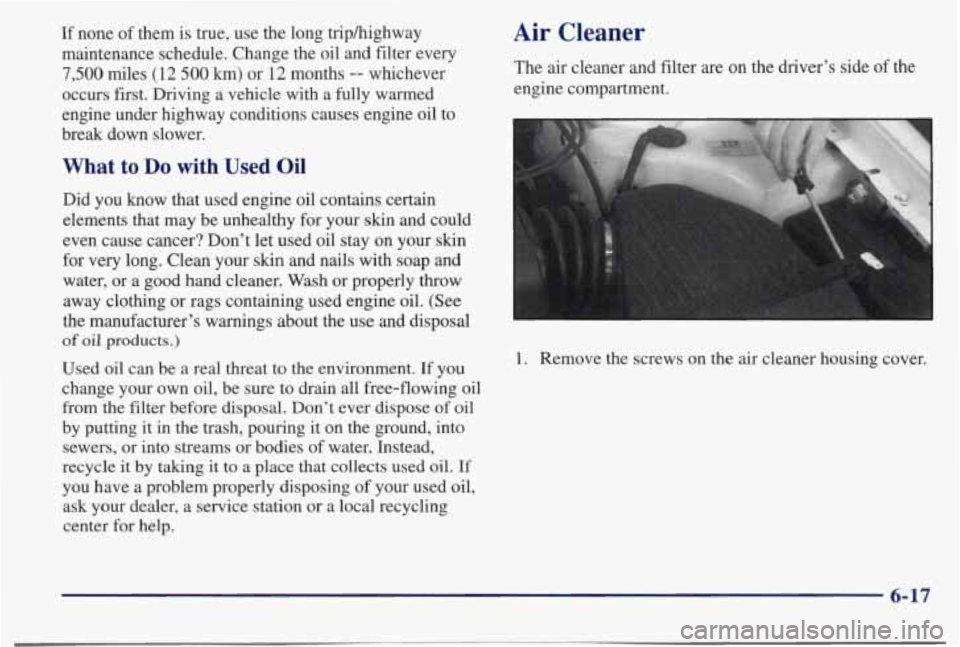
If none of them is true, use the long triphighway
maintenance schedule. Change the oil and filter every
7,500 miles (12 500 km) or 12 months -- whichever
occurs first. Driving a vehicle with a fully warmed
engine under highway conditions causes engine oil to
break down slower.
What to Do with Used Oil
Did you know that used engine oil contains certain
elements that may be unhealthy for your
skin and could
even cause cancer? Don’t let used oil stay on your skin
for very long. Clean your
skin and nails with soap and
water, or a
good hand cleaner. Wash or properly throw
away clothing or rags containing used engine oil. (See
the manufacturer’s warnings about the use and
disposal
of oil products.)
Used oil can be a real threat to the environment. If you
change your own oil, be sure to drain all free-flowing oil
from
the filter before disposal. Don’t ever dispose of oil
by putting it in the trash, pouring it on the ground, into
sewers, or into streams or bodies of water. Instead,
recycle
it by taking it to a place that collects used oil. If
you have a problem properly disposing of your used oil,
ask your dealer, a service station or a local recycling
center for
help.
Air Cleaner
The air cleaner and filter are on the driver’s side of the
engine compartment.
1. Remove the screws on the air cleaner housing cover.
6-17
Page 274 of 395
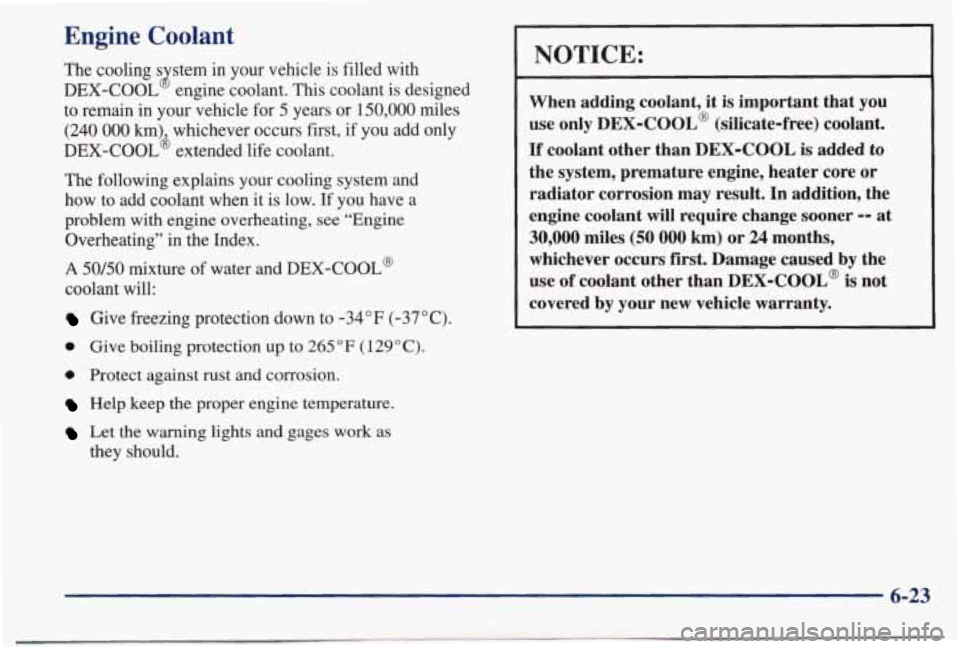
Engine Coolant
The cooling s stem in your vehicle is filled with
DEX-COOL
8 engine coolant. This coolant is designed
to remain in your vehicle for
5 years or 150,000 miles
(240 000 km) whichever occurs first, if you add only
DEX-COOL’ extended life coolant.
The following explains your cooling system and
how to add coolant when it is low. If you have a
problem with engine overheating,
see “Engine
Overheating”
in the Index.
A 50/50 mixture of water and DEX-COOL@
coolant will:
Give freezing protection down to -34°F (-37°C).
0 Give boiling protection up to 265 “F (129°C).
0 Protect against rust and corrosion.
Help keep the proper engine temperature.
Let the warning lights and gages work as
they should.
NOTICE:
When adding coolant, it is important that you
use only DEX-COOL@ (silicate-free) coolant.
If coolant other than DEX-COOL is added to
the system, premature engine, heater core or
radiator corrosion may result. In addition, the
engine coolant
will require change sooner -- at
30,000 miles (50 000 km) or 24 months,
whichever occurs first. Damage caused by the
use of coolant other than DEX-COOL@
is not
covered by your new vehicle warranty.
6-23
Page 275 of 395
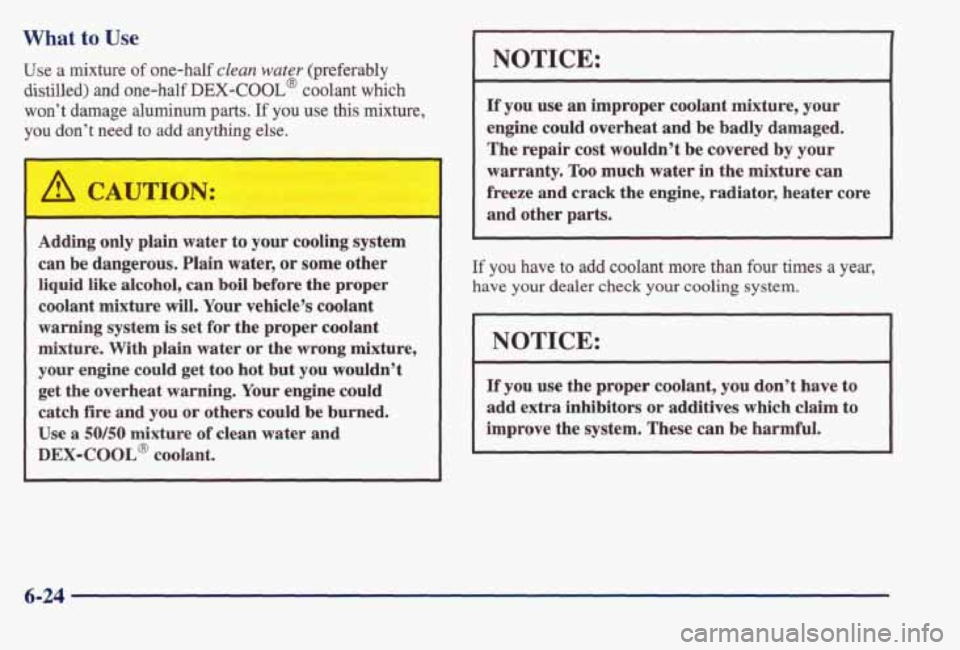
What to Use
Use a mixture of one-half clean water (preferably
distilled) and one-half DEX-COOL@ coolant which
won’t
damage aluminum parts. If you use this mixture,
you
don’t need to add anything else.
Adding only plain water to your cooling system
can be dangerous. Plain water, or some other
liquid
like alcohol, can boil before the proper
coolant mixture will. Your vehicle’s coolant
warning system
is set for the proper coolant
mixture. With plain water or the wrong mixture,
your engine could get too hot but you wouldn’t
get the overheat warning. Your engine could
catch fire and
you or others could be burned.
Use
a 50/50 mixture of clean water and
DEX-COOL@ coolant.
NOTICE:
If you use an improper coolant mixture, your
engine could overheat and be badly damaged.
The repair cost wouldn’t be covered by your
warranty. Too much water in the mixture can
freeze and crack the engine, radiator, heater core
and other parts.
If you have to add coolant more than four times a year,
have your dealer check your cooling system.
I NOTICE:
If you use the proper coolant, you don’t have to
add extra inhibitors or additives which claim to
improve the system. These can be harmful.
6-24
Page 280 of 395
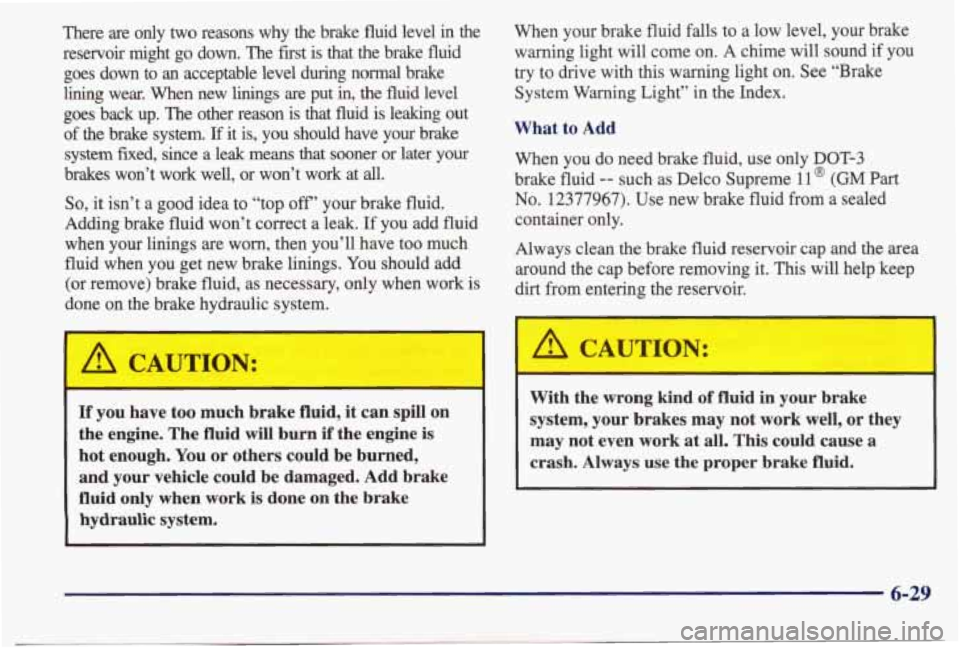
There are only two reasons why the brake fluid level in the
reservoir might go down. The first is that the brake fluid
goes down to
an acceptable level during normal brake
lining wear. When new linings are put in, the fluid level
goes back up. The other reason is that fluid is leaking out
of the brake system.
If it is, you should have your brake
system fixed, since a leak means that sooner or later your
brakes won’t work well, or won’t work at
all.
So, it isn’t a good idea to “top off’ your brake fluid.
Adding brake fluid won’t correct a leak.
If you add fluid
when your linings
are worn, then you’ll have too much
fluid when you get new brake linings. You should add
(or remove) brake fluid, as necessary, only when work
is
done on the brake hydraulic system.
I A CAUTION:
When your brake fluid falls to a low level, your brake
warning light will come on.
A chime will sound if you
try to drive with this warning light on. See “Brake
System
Warning Light” in the Index.
What to Add
When you do need brake fluid, use only DOT-3
brake fluid -- such as Delco Supreme 11 @ (GM Part
No. 12377967). Use new brake fluid from a sealed
container only.
Always clean the brake fluid reservoir cap and the area
around the cap before removing it.
This will help keep
dirt from entering the reservoir.
If you have too much brake fluid, it can spill on
the engine. The fluid will burn if the engine
is
hot enough. You or others could be burned,
and your vehicle could be damaged. Add brake
fluid only when work is done on the brake
hydraulic system.
I b, CAUTION:
With the wrong kind of fluid in your brake
system, your brakes may not work well, or they
may not even work
at all. This could cause a
crash. Always use the proper brake fluid.
6-29
Page 281 of 395
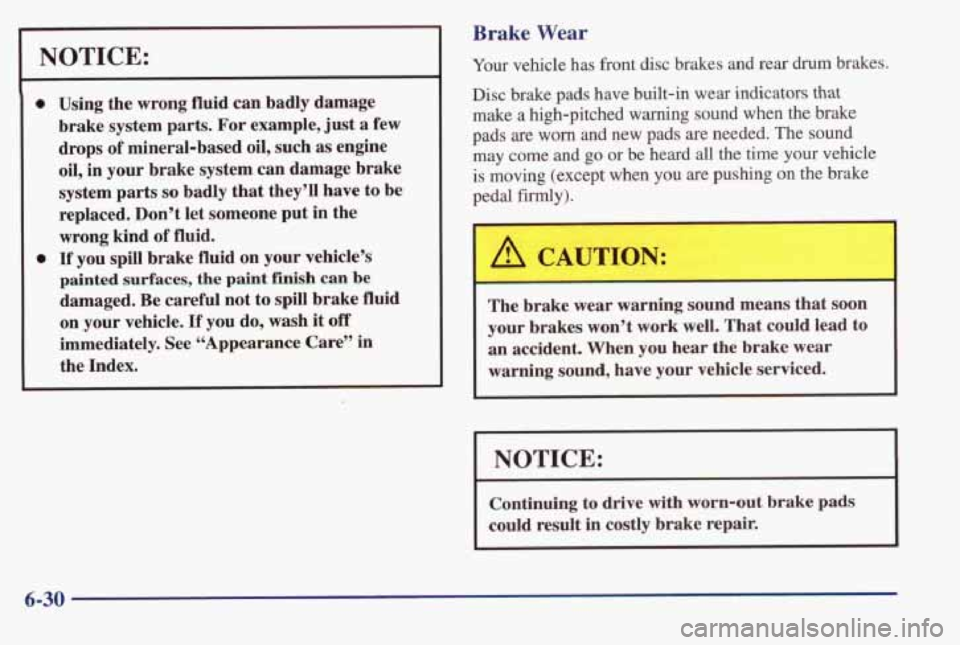
-
NOTICE:
0
0
Using the wrong fluid can badly damage
brake system parts. For example, just a few
drops
of mineral-based oil, such as engine
oil, in your brake system can damage brake
system parts
so badly that they’ll have to be
replaced. Don’t let someone put in the
wrong kind
of fluid.
If you spill brake fluid on your vehicle’s
painted surfaces, the paint finish can be
damaged. Be careful not to spill brake fluid
on your vehicle. If you do, wash it off
immediately. See “Appearance Care” in
the Index.
Brake Wear
Your vehicle has front disc brakes and rear drum brakes.
Disc brake pads have built-in wear indicators
that
make a high-pitched warning sound when the brake
pads are worn and new pads are needed. The sound
may come
and go or be heard all the time your vehicle
is moving (except when
you are pushing on the brake
pedal
firmly).
A 3
,A CAUTION:
I I
The brake wear warning sound means that soon
your brakes won’t work well. That could lead to
an accident. When you hear the brake wear
warning sound, have your vehicle serviced.
I I
I NOTICE: I ~
Continuing to drive with worn-out brake pads
could result
in costly brake repair. I
6-30
Page 297 of 395

Treadwear
The treadwear grade is a comparative rating based on
the wear rate
of the tire when tested under controlled
conditions on a specified government test course.
For example, a tire graded 150 would wear one
and a
half (1 1/2) times as well on the government course
as a tire graded 100. The relative performance of tires
depends upon the actual conditions
of their use,
however, and may depart significantly from the norm
due to variations
in driving habits, service practices
and differences in road characteristics and climate.
Traction -- A, B, C
The traction grades, from highest to lowest, are A, B,
and C, and they represent the tire’s ability to stop on
wet pavement as measured under controlled conditions
on specified government test surfaces of asphalt
and concrete.
A tire marked C may have poor
traction performance.
Warning: The traction grade assigned
to this tire is based
on braking (straight ahead) traction tests and does not
include cornering (turning) traction.
Temperature -- A, B, C
The temperature grades are A (the highest), B, and C,
representing the tire’s resistance to the generation of
heat and its ability to dissipate heat when tested under
controlled conditions on a specified indoor laboratory
test wheel. Sustained high temperature can cause the
material
of the tire to degenerate and reduce tire life, and
excessive temperature can lead to sudden
tire failure.
The grade
C corresponds to a level of performance
which
all passenger car tires must meet under the
Federal Motor Vehicle Safety Standard
No. 109. Grades
B and A represent higher levels of performance on the
laboratory test wheel
than the minimum required by law.
Warning: The temperature grade for this tire is
established for a tire that is properly inflated and not
overloaded. Excessive speed, underinflation, or
excessive loading, either separately or in combination,
can cause heat buildup and possible tire failure.
6-46
Page 300 of 395
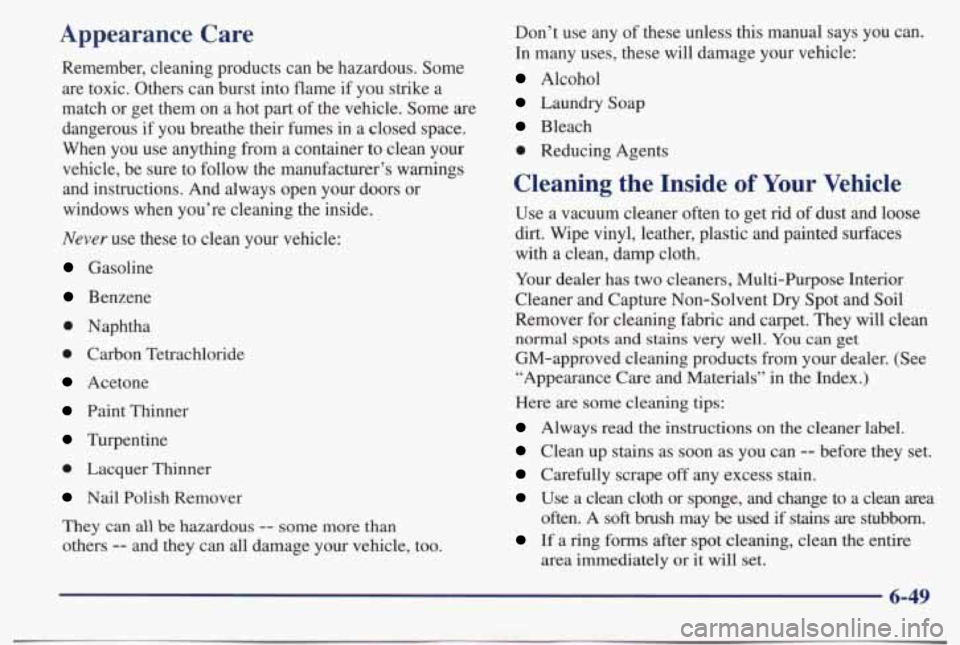
Appearance Care
Remember, cleaning products can be hazardous. Some
are toxic. Others can burst into flame if you strike a
match or get them on a hot part of the vehicle. Some are
dangerous if you breathe their fumes in a closed space.
When you use anything from a container
to clean your
vehicle, be sure to follow the manufacturer’s warnings
and instructions. And always open your doors or
windows when you’re cleaning the inside.
Never use these to clean your vehicle:
Gasoline
Benzene
0 Naphtha
0 Carbon Tetrachloride
Acetone
Paint Thinner
Turpentine
0 Lacquer Thinner
Nail Polish Remover
They can all be hazardous -- some more than
others
-- and they can all damage your vehicle, too. Don’t
use any
of these unless this manual says you can.
In many uses, these will damage your vehicle:
Alcohol
Laundry Soap
Bleach
0 Reducing Agents
Cleaning the Inside of Your Vehicle
Use a vacuum cleaner often to get rid of dust and loose
dirt. Wipe vinyl, leather, plastic and painted surfaces with a clean, damp cloth.
Your dealer has two cleaners, Multi-Purpose Interior
Cleaner and Capture Non-Solvent
Dry Spot and Soil
Remover
for cleaning fabric and carpet. They will clean
normal spots and stains very well. You can get
GM-approved cleaning products from your dealer.
(See
“Appearance Care and Materials” in the Index.)
Here
are some cleaning tips:
Always read the instructions on the cleaner label.
Clean up stains as soon as you can -- before they set.
Carefully scrape off any excess stain.
Use a clean cloth or sponge, and change to a clean area
If a ring forms after spot cleaning, clean the entire
often.
A
soft brush may be used if stains are stubborn.
area immediately
or it will set.
6-49
Page 374 of 395
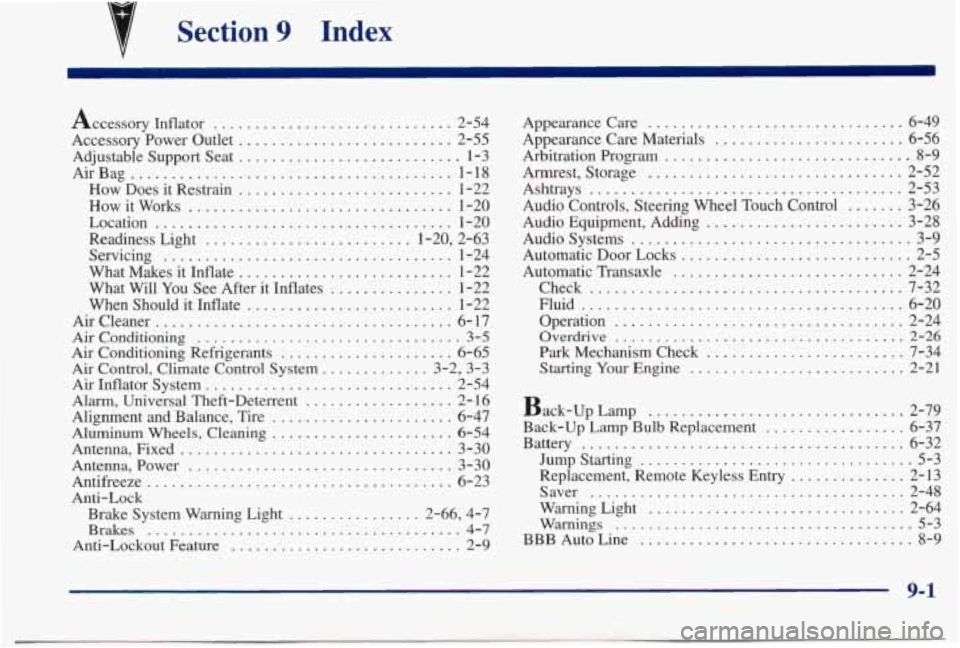
Section 9 Index
Accessory Inflator ............................. 2-54
Accessory Power Outlet
.......................... 2-55
Adjustable Support Seat
........................... 1-3
AirBag
....................................... 1-18
How Does it Restrain
... .................. 1-22
How
it Works ................................ 1-20
Location
.................................... 1-20
Readiness Light
......................... 1.20. 2.63
Servicing
................................... 1-24
What Makes it Inflate
.......................... 1-22
What Will
You See After it Inflates ............... 1-22
When Should it Inflate
......................... 1-22
Air Cleaner .................................... 6- 17
Airconditioning
................................ 3-5
Air Conditioning Refrigerants ..................... 6-65
Air Control. Climate Control System
............. 3-2. 3-3
Air Inflator System
.............................. 2-54 Appearance Care
............................... 6-49
Appearance Care Materials
....................... 6-56
Arbitration Program
.............................. 8-9
Armrest. Storage
............................... 2-52
Ashtrays
...................................... 2-53
Audio Equipment. Adding
........................ 3-28
Audio Systems
.................................. 3-9
Automatic Door Locks
............................ 2-5
Automatic Transaxle
............................ 2-24
Check
.. : ................................... 7-32
Fluid
....................................... 6-20
Operation
................................... 2-24
Overdrive
................................... 2-26
Park Mechanism Check ........................ 7-34
Audio Controls. Steering Wheel Touch Control
....... 3-26
Starting Your Engine
.......... ......... 2-21
Alarm. Univ6rsal Theft-Deterrent .................. 2- 16
Alignment and Balance. Tire
...................... 6-47 Back-up amp 2-79
Aluminum Wheels. Cleaning
...................... 6-54 Back-up Lamp Bulb Replacement 6-37
Antenna. Fixed
................................. 3-30 Battery 6-32
Antenna. Power
................................ 3-30 Jumpstarting 5-3
Antifreeze
..................................... 6-23 Replacement. Remote Keyless Entry 2-13
Anti-Lock Saver 2-48
Brakes ...................................... 4-7 Warnings 5-3
Anti-Lockout Feature ............................ 2-9 BBB Auto Line 8-9
...............................
.................
.......................................
.................................
..............
......................................
............................... Brake System Warning Light .......... . . 2-66. 4-7 WarningLight 2-64 ....................................
.................................
9-1